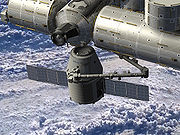
COTS Demo Flight 3
Encyclopedia

SpaceX
Space Exploration Technologies Corporation, or more popularly and informally known as SpaceX, is an American space transport company that operates out of Hawthorne, California...
's unpiloted Dragon cargo spacecraft, and the fourth overall flight of the company's two-stage Falcon 9
Falcon 9
Falcon 9 is a rocket-powered spaceflight launch system designed and manufactured by SpaceX. Both stages of its two-stage-to-orbit vehicle use liquid oxygen and rocket-grade kerosene propellants...
launch vehicle. Originally, this flight was intended to be Dragon's first mission to dock with the International Space Station
International Space Station
The International Space Station is a habitable, artificial satellite in low Earth orbit. The ISS follows the Salyut, Almaz, Cosmos, Skylab, and Mir space stations, as the 11th space station launched, not including the Genesis I and II prototypes...
(ISS), as part of NASA
NASA
The National Aeronautics and Space Administration is the agency of the United States government that is responsible for the nation's civilian space program and for aeronautics and aerospace research...
's Commercial Orbital Transportation Services
Commercial Orbital Transportation Services
Commercial Orbital Transportation Services is a NASA program to coordinate the delivery of crew and cargo to the International Space Station by private companies. The program was announced on January 18, 2006...
(COTS) Phase 1 contract. Following a July 15, 2011 meeting between SpaceX and NASA officials, the COTS 3 mission objectives were tentatively combined with the proposed COTS 2
COTS Demo Flight 2
Dragon C2, also known as COTS Demo Flight 2, is a planned second test-flight for SpaceX's unpiloted Dragon cargo spacecraft, and the third overall flight for the company's two-stage Falcon 9 launch vehicle....
demonstration flight, due to the Falcon 9's two previously successful launches, and the Space Transportation System
Space Transportation System
The Space Transportation System is another name for the NASA Space Shuttle and Space Shuttle program. However, the name originates from, and can describe a more elaborate set of spacefaring hardware in the 1970s, although this meaning is obscure...
's shuttle fleet recently being retired. NASA will make the final determination whether or not to allow the COTS-2 Dragon spacecraft to berth with the ISS after it is launched, because SpaceX intends to launch two secondary payload satellites from the Dragon sometime in the first 72 hours after launch. If allowed to berth, the mission is projected to last 22-days and the COTS-2 mission will complete the originally planned COTS-3 mission. If permission is denied for COTS 2 to berth, or there is a failure of some kind, then the original COTS 3 mission will still be needed.
With the merging of the Dragon C2 and Dragon C3 missions, the Dragon C2 launch is tentatively scheduled for 7 January 2012 from Cape Canaveral Launch Complex 40 (SLC-40). The mission's primary objectives include demonstrating a remotely-controlled space rendezvous
Space rendezvous
A space rendezvous is an orbital maneuver during which two spacecraft, one of which is often a space station, arrive at the same orbit and approach to a very close distance . Rendezvous requires a precise match of the orbital velocities of the two spacecraft, allowing them to remain at a constant...
and docking with the ISS. After leaving the ISS, the spacecraft will perform a controlled de-orbit burn to re-enter the Earth's atmosphere, and SpaceX will attempt recovery after a planned splashdown in the Pacific Ocean
Pacific Ocean
The Pacific Ocean is the largest of the Earth's oceanic divisions. It extends from the Arctic in the north to the Southern Ocean in the south, bounded by Asia and Australia in the west, and the Americas in the east.At 165.2 million square kilometres in area, this largest division of the World...
.

